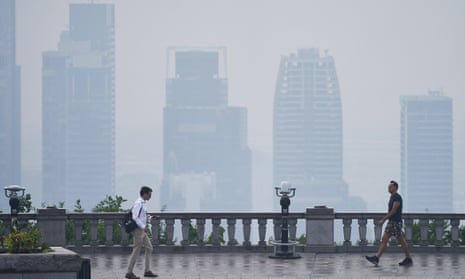Wildfires raging across Canada, made more intense by global warming, have released more planet-warming carbon dioxide in the first six months of 2023 than in any full year on record, according to the EU’s Copernicus Atmosphere Monitoring Service.
This year’s wildfire season is the worst on record in Canada, with some 76,000sq km (29,000sq miles) burning across eastern and western Canada. That is already greater than the combined area burned in 2016, 2019, 2020 and 2022, according to the Canadian Interagency Forest Fire Centre.
Hundreds of forest fires since early May have generated nearly 160m tonnes of carbon, the Copernicus Atmosphere Monitoring Service (CAMS) reported. This is equivalent to nearly 600m tonnes of carbon dioxide.
More than half of that carbon pollution went up in smoke in June alone.
“The emissions from these wildfires are now the largest annual emissions for Canada in the 21 years of our dataset,” CAMS said in a statement.
Canada’s wildfire season typically peaks in late July or August, with emissions continuing to climb throughout the summer.
As of Tuesday, firefighters were battling 494 blazes throughout the country, more than half of them classified as out-of-control, according to the Canadian Interagency Forest Fire Centre.
Drifting smoke from the ongoing wildfires is creating curtains of haze and raising air quality concerns throughout the Great Lakes region, and in parts of the central and eastern United States.
Michigan’s department of environment, Great Lakes and energy on Tuesday issued an air quality alert for the entire state, while in Chicago –– where the air quality has been categorized “unhealthy” by the US Environmental Protection Agency – officials are urging young people, older adults and residents with health issues to spend more time indoors.
Forests act as a critical sink for planet-warming carbon. It is estimated that Canada’s northern boreal forest stores more than 200bn tonnes of carbon – equivalent to several decades worth of global carbon emissions. But when forests burn, they release some of that carbon into the atmosphere. This speeds up global warming and creates a dangerous feedback loop by creating the conditions where forests are more likely to burn.
Smoke from the Canadian wildfires blanketed several major urban centres in June, including New York City and Toronto, tingeing skies an eerie orange.
Public health authorities issued air quality alerts, urging residents to stay inside. Wildfire smoke is linked to higher rates of heart attacks, strokes and more visits to emergency rooms for respiratory conditions.
Now, the plume has crossed the North Atlantic. Worsening fires in Quebec and Ontario will probably make for hazy skies and deep orange sunsets in Europe this week, Parrington said.
With much of Canada still experiencing unusually warm and dry conditions, “there’s still no end in sight”, Parrington said.
